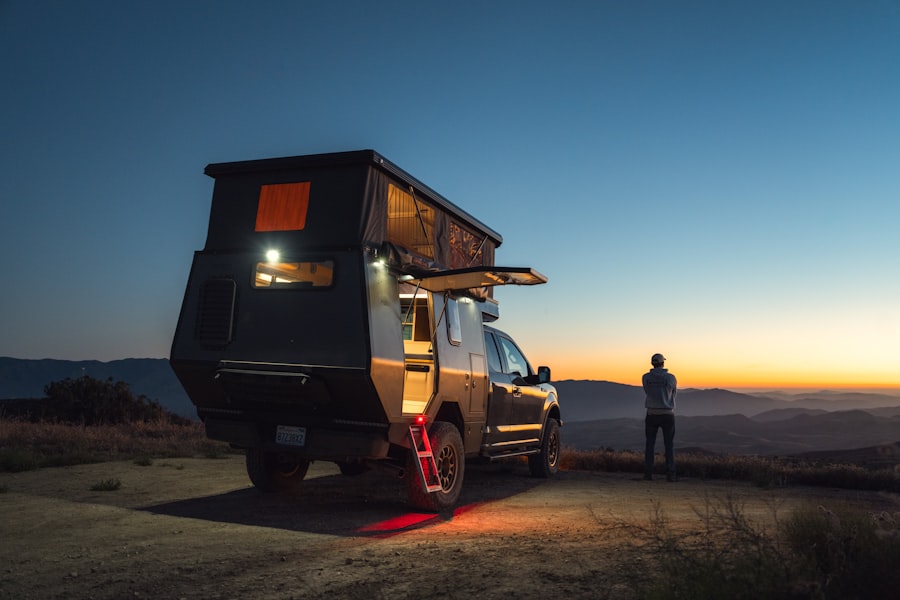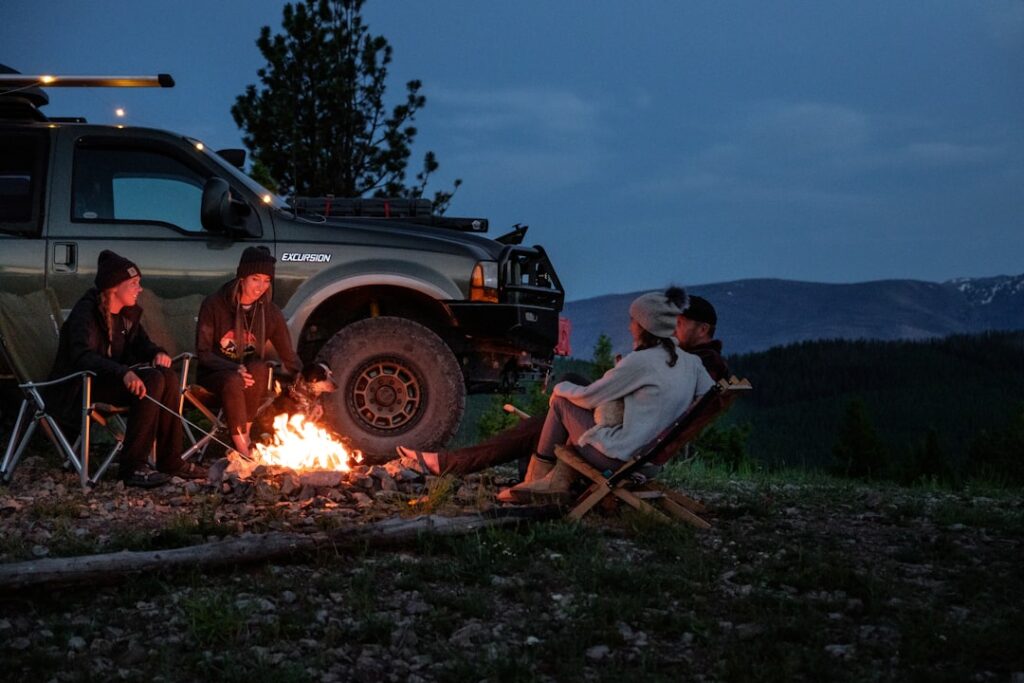Overlanding is a unique form of travel that emphasizes self-sufficiency and adventure, often involving long-distance journeys across diverse terrains. Unlike traditional road trips, overlanding typically requires travelers to venture off the beaten path, exploring remote areas that are less accessible by conventional means. This mode of travel is characterized by the use of rugged vehicles equipped for off-road conditions, allowing adventurers to traverse challenging landscapes such as deserts, mountains, and forests.
The essence of overlanding lies in the journey itself, where the experience of exploration and discovery takes precedence over reaching a specific destination. At its core, overlanding is about immersing oneself in nature and embracing the unpredictability of the great outdoors. It encourages travelers to engage with their surroundings, whether that means camping under the stars, cooking meals over an open fire, or navigating through uncharted territories.
This form of travel fosters a deep connection with the environment and often leads to encounters with wildlife and breathtaking landscapes. Overlanding is not merely a means of transportation; it is a lifestyle choice that promotes adventure, resilience, and a profound appreciation for the natural world.
Key Takeaways
- Overlanding is a self-reliant vehicle-based adventure travel to remote destinations.
- Choose a vehicle with off-road capabilities, ample storage, and good fuel efficiency for overlanding.
- Essential gear for overlanding includes navigation tools, camping equipment, first aid kit, and emergency supplies.
- Plan your overlanding route by researching the terrain, weather conditions, and potential camping spots.
- Safety tips for overlanding in remote areas include carrying communication devices, informing others of your plans, and being prepared for emergencies.
Choosing the Right Vehicle for Overlanding
Selecting the appropriate vehicle for overlanding is crucial to ensuring a successful and enjoyable adventure. The ideal overlanding vehicle should be capable of handling various terrains while providing comfort and reliability for long journeys. Many enthusiasts opt for four-wheel-drive vehicles, such as SUVs or trucks, which offer the necessary power and traction to navigate rough roads and off-road trails.
Additionally, vehicles equipped with high ground clearance and durable suspension systems are essential for tackling obstacles like rocks, mud, and steep inclines. Beyond just capability, potential overlanders must also consider the vehicle’s storage capacity and fuel efficiency. Since overlanding often involves extended periods away from civilization, having ample space for gear, supplies, and camping equipment is vital.
Furthermore, fuel efficiency can significantly impact the overall cost of an adventure, especially when traversing remote areas where fuel stations may be scarce. Ultimately, the right vehicle should strike a balance between ruggedness and comfort, ensuring that travelers can enjoy their journey without compromising on safety or convenience.
Essential Gear and Supplies for Overlanding Adventures

Equipping oneself with the right gear and supplies is fundamental to a successful overlanding experience. Essential items include camping equipment such as tents, sleeping bags, and cooking gear. A high-quality tent that can withstand various weather conditions is crucial for providing shelter during nights spent outdoors.
Additionally, portable cooking equipment like camp stoves or grills allows travelers to prepare meals in remote locations, enhancing the overall experience of living off the land. In addition to camping gear, safety equipment should not be overlooked. First aid kits, emergency tools, and navigation devices are vital for addressing unforeseen circumstances that may arise during an adventure.
A reliable GPS system or map can help travelers stay oriented in unfamiliar territories, while communication devices like satellite phones can provide peace of mind in case of emergencies. By carefully selecting gear that prioritizes safety and comfort, overlanders can focus on enjoying their journey without unnecessary worries.
Planning Your Overlanding Route
| Route Planning Metrics | Details |
|---|---|
| Destination | Choose the specific locations you want to visit |
| Distance | Calculate the total distance of your route |
| Duration | Estimate the time it will take to complete the route |
| Terrain | Consider the type of terrain you will encounter |
| Points of Interest | Identify any attractions or landmarks along the route |
Planning an overlanding route requires careful consideration of various factors to ensure a smooth and enjoyable journey. One of the first steps is to research potential destinations and identify points of interest along the way. This may include national parks, scenic viewpoints, or historical landmarks that can enhance the overall experience.
Additionally, understanding the terrain and road conditions is essential for selecting routes that match the capabilities of the chosen vehicle. Another critical aspect of route planning involves considering the availability of resources such as fuel stations, water sources, and campsites. Overlanders should map out these essential stops to avoid running into difficulties in remote areas where services may be limited.
Flexibility is also key; while having a planned route is beneficial, being open to spontaneous detours can lead to unexpected adventures and discoveries. Ultimately, thorough planning combined with a spirit of adventure will create a memorable overlanding experience.
Safety Tips for Overlanding in Remote Areas
Safety should always be a top priority when embarking on an overlanding adventure in remote areas. One of the most important tips is to inform someone about travel plans before setting out. Sharing details about intended routes and estimated return times can provide an added layer of security in case of emergencies.
Additionally, carrying a comprehensive first aid kit and knowing basic first aid skills can be invaluable in addressing injuries or health issues that may arise during the journey. Travelers should also be aware of their surroundings and prepared for potential hazards such as wildlife encounters or extreme weather conditions. Understanding how to react in various situations—whether it’s encountering a bear or navigating through a sudden storm—can make all the difference in ensuring safety.
Moreover, having reliable communication devices like satellite phones or two-way radios can facilitate contact with others in case of emergencies. By prioritizing safety measures and being prepared for unexpected challenges, overlanders can enjoy their adventures with greater peace of mind.
Finding the Best Campsites for Overlanding

Finding suitable campsites is an integral part of any overlanding adventure. The ideal campsite should offer not only safety but also stunning views and access to natural resources like water and firewood. Many overlanders prefer to camp in designated campgrounds within national parks or forests, as these locations often provide amenities such as restrooms and picnic tables.
However, for those seeking solitude and a deeper connection with nature, dispersed camping in remote areas can offer unparalleled experiences. When selecting a campsite, it’s essential to consider factors such as proximity to water sources and potential hazards like flooding or wildlife activity. Additionally, respecting local regulations regarding camping practices is crucial for preserving natural habitats.
Overlanders should aim to leave no trace by minimizing their impact on the environment—this includes properly disposing of waste and avoiding damage to vegetation. By choosing campsites thoughtfully and practicing responsible camping habits, adventurers can enjoy their time in nature while protecting it for future generations.
Connecting with Nature: Wildlife Viewing and Nature Photography
One of the most rewarding aspects of overlanding is the opportunity to connect with nature through wildlife viewing and photography. Remote areas often serve as habitats for diverse species, providing travelers with unique chances to observe animals in their natural environments. Whether it’s spotting deer grazing at dawn or witnessing birds soaring overhead, these encounters can create lasting memories that enrich the overall experience.
For those interested in photography, overlanding offers countless opportunities to capture breathtaking landscapes and wildlife moments. Early mornings and late afternoons are often considered the best times for photography due to the soft lighting conditions that enhance natural beauty. Travelers should also consider investing in quality camera equipment that allows them to capture high-resolution images from a distance without disturbing wildlife.
By embracing these moments of connection with nature, overlanders can deepen their appreciation for the environment while creating visual stories that reflect their adventures.
Overlanding Etiquette: Respecting the Environment and Local Communities
Practicing good etiquette while overlanding is essential for fostering positive relationships with local communities and preserving natural environments. Respecting local customs and traditions is paramount; travelers should take time to learn about the cultures they encounter along their journey. This includes being mindful of noise levels, dressing appropriately when visiting local villages, and supporting local businesses whenever possible.
Additionally, environmental stewardship plays a significant role in responsible overlanding practices. Travelers should adhere to Leave No Trace principles by minimizing their impact on natural surroundings—this includes packing out all trash, avoiding campfires in sensitive areas, and staying on designated trails to prevent soil erosion. By demonstrating respect for both people and nature, overlanders contribute to sustainable travel practices that benefit everyone involved.
Overlanding with Pets: Tips for Traveling with Your Furry Friends
For many adventurers, bringing pets along on an overlanding trip can enhance the experience by providing companionship and joy during travels. However, traveling with pets requires careful planning to ensure their safety and comfort throughout the journey. One important consideration is selecting pet-friendly campsites that allow animals; many national parks have specific regulations regarding pets on trails or in campgrounds.
Additionally, ensuring pets are well-prepared for outdoor adventures is crucial. This includes bringing along necessary supplies such as food, water bowls, leashes, and first aid kits specifically designed for animals. It’s also wise to familiarize pets with car travel before embarking on long journeys; gradual acclimatization can help reduce anxiety during extended drives.
By taking these precautions into account, overlanders can create enjoyable experiences for both themselves and their furry companions.
Overlanding as a Family: Tips for Traveling with Kids
Overlanding can be an enriching experience for families looking to bond through adventure while exploring nature together. However, traveling with children requires thoughtful planning to ensure everyone’s enjoyment throughout the journey. One effective strategy is involving kids in the planning process; allowing them to choose destinations or activities can foster excitement about the trip ahead.
Safety considerations are paramount when traveling with children; ensuring they understand basic outdoor safety rules—such as staying close to adults and recognizing potential hazards—can help prevent accidents during adventures. Additionally, packing engaging activities like books or games can keep kids entertained during long drives or downtime at campsites. By prioritizing family-friendly practices while embracing spontaneity along the way, families can create lasting memories through their overlanding experiences.
Overlanding Solo: Tips for Solo Travelers in the Great Outdoors
Solo overlanding offers a unique opportunity for self-discovery and personal growth amidst nature’s beauty. However, embarking on an adventure alone requires careful preparation to ensure safety and enjoyment throughout the journey. One essential tip for solo travelers is to establish clear communication plans; sharing itineraries with friends or family members provides an added layer of security in case of emergencies.
Additionally, solo adventurers should prioritize self-sufficiency by equipping themselves with essential gear such as navigation tools and emergency supplies tailored specifically for solo travel scenarios. Building confidence through practice—such as honing off-road driving skills or learning basic survival techniques—can enhance overall preparedness during solo journeys into remote areas. By embracing independence while remaining vigilant about safety measures, solo travelers can fully immerse themselves in transformative experiences offered by overlanding adventures.
FAQs
What is overlanding?
Overlanding is a self-reliant adventure travel to remote destinations where the journey is the primary goal. It typically involves off-road travel and can last for extended periods of time.
What kind of vehicles are used for overlanding?
Overlanding can be done with a variety of vehicles, including 4×4 trucks, SUVs, motorcycles, and even bicycles. The choice of vehicle depends on the terrain and the preferences of the overlander.
What are the essential gear and equipment for overlanding?
Essential gear for overlanding includes camping equipment, cooking supplies, navigation tools, communication devices, recovery gear, and spare parts for the vehicle. Overlanders also need to carry sufficient food, water, and fuel for the journey.
Where do overlanders typically go?
Overlanders often travel to remote and rugged destinations such as national parks, deserts, mountains, and other off-the-beaten-path locations. Popular overlanding routes include the Pan-American Highway, the Silk Road, and the Trans-America Trail.
What are the benefits of overlanding?
Overlanding allows travelers to experience remote and untouched landscapes, connect with nature, and immerse themselves in different cultures. It also promotes self-sufficiency, problem-solving skills, and a sense of adventure.









